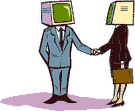Natural and artificial intelligence

The analogy between machines and the brain has fascinated men and scientists since when the first computers - or electronic brains, as they were called originally - were built. Back in 1950, Alan Turing, the father of modern artificial intelligence, proposed a hypothetical crucial test able to prove that a computer had reached a level of intelligence, not only computational but also emotional, comparable to human intelligence. According to Turing, the test could be considered passed when a person interviewing a man and a computer through a remote connection is unable to decide which is the machine and which is the human. Despite the fact that the computational power of computers grows in an exponential way and more than doubles every year, and that it is estimated that by the year 2040 a 1000 - dollar computer will reach the computational power of all existing human brains, no computer has so far been able to pass something equivalent to the Turing test.
In addition to building computers of increasing computational potency which work through processes not comparable to cerebral ones, scientists in the field of artificial intelligence are developing computational systems, such as neural networks, which are based on the essential properties of brain circuits, synaptic plasticity and the ability to modify their activity as a consequence of previous activity and learning. Some optimistic students of artificial intelligence forecast that, in the course of the present century, not only will computers possessing some form of consciousness and human emotions exist but also that computers will evolve from the status of intelligent machines to the status of spiritual machines, establishing forms of symbiosis with human beings.